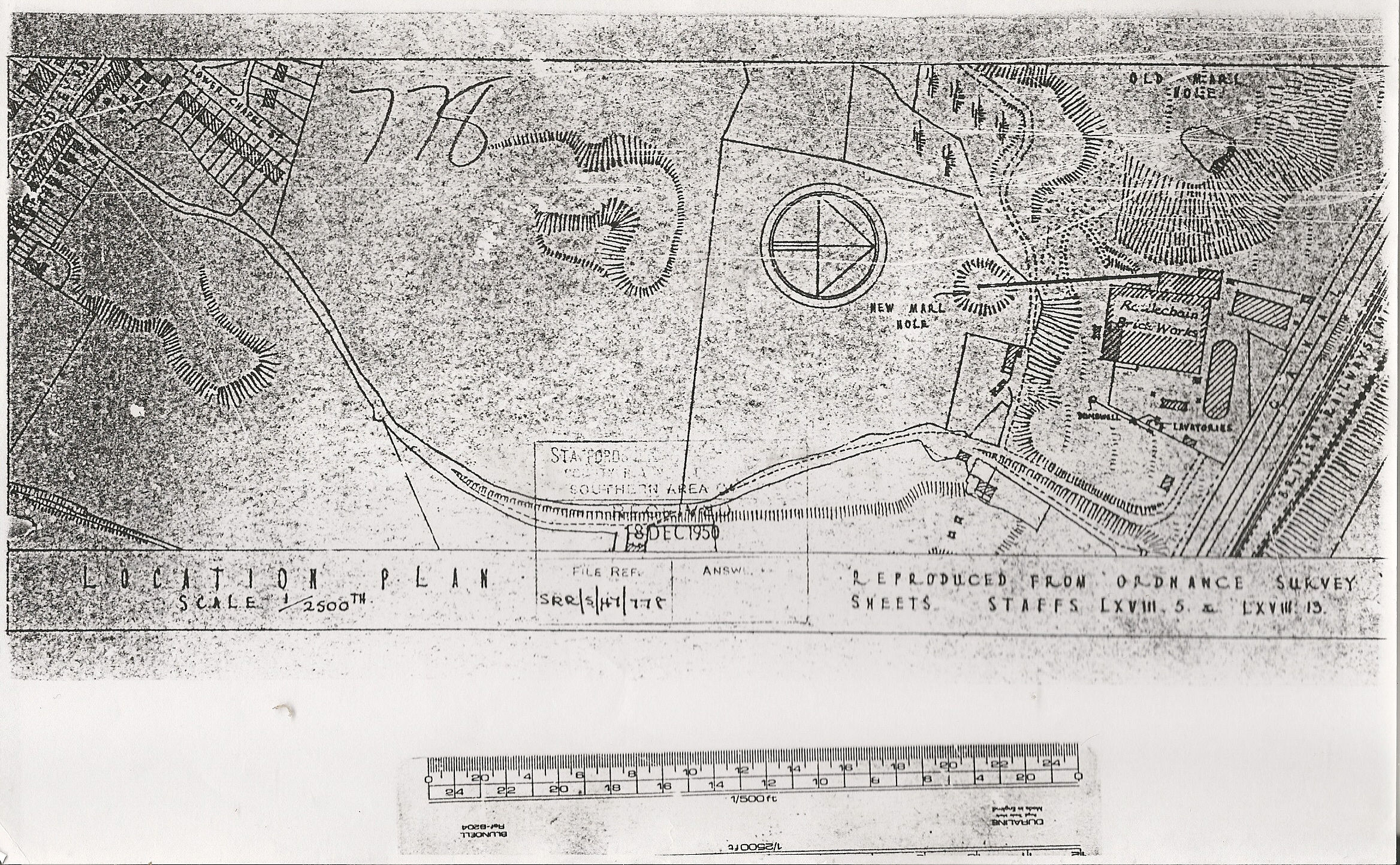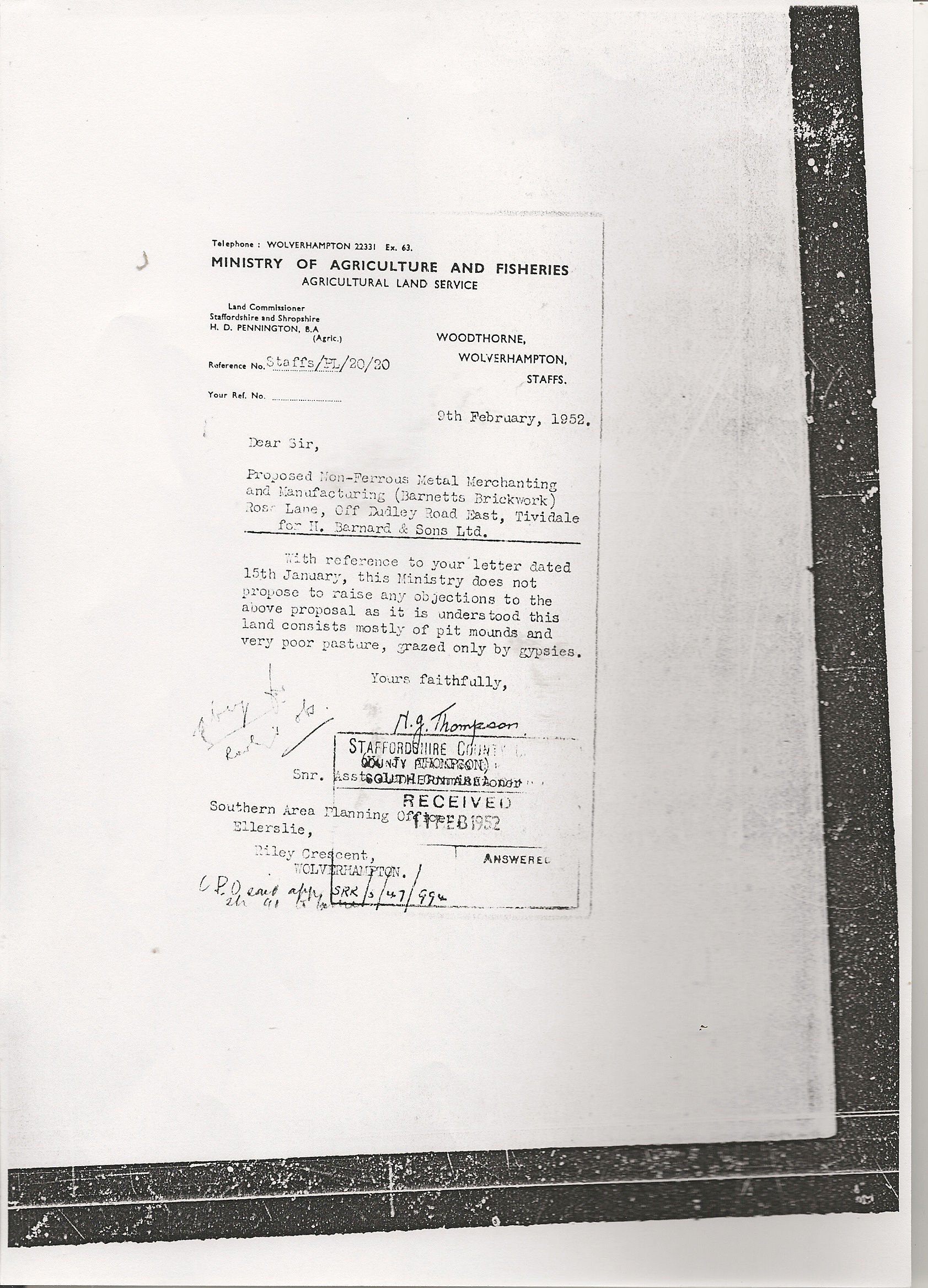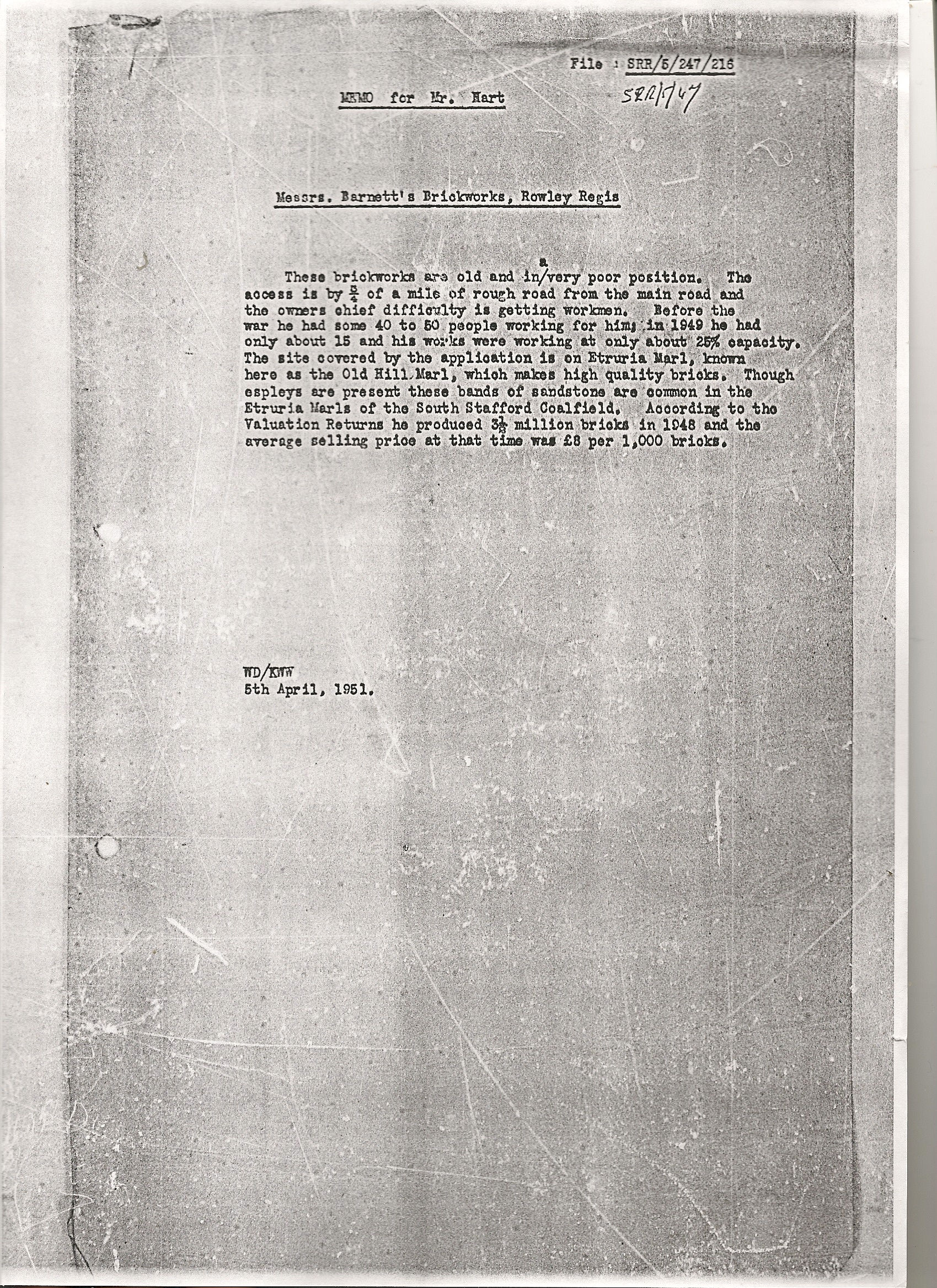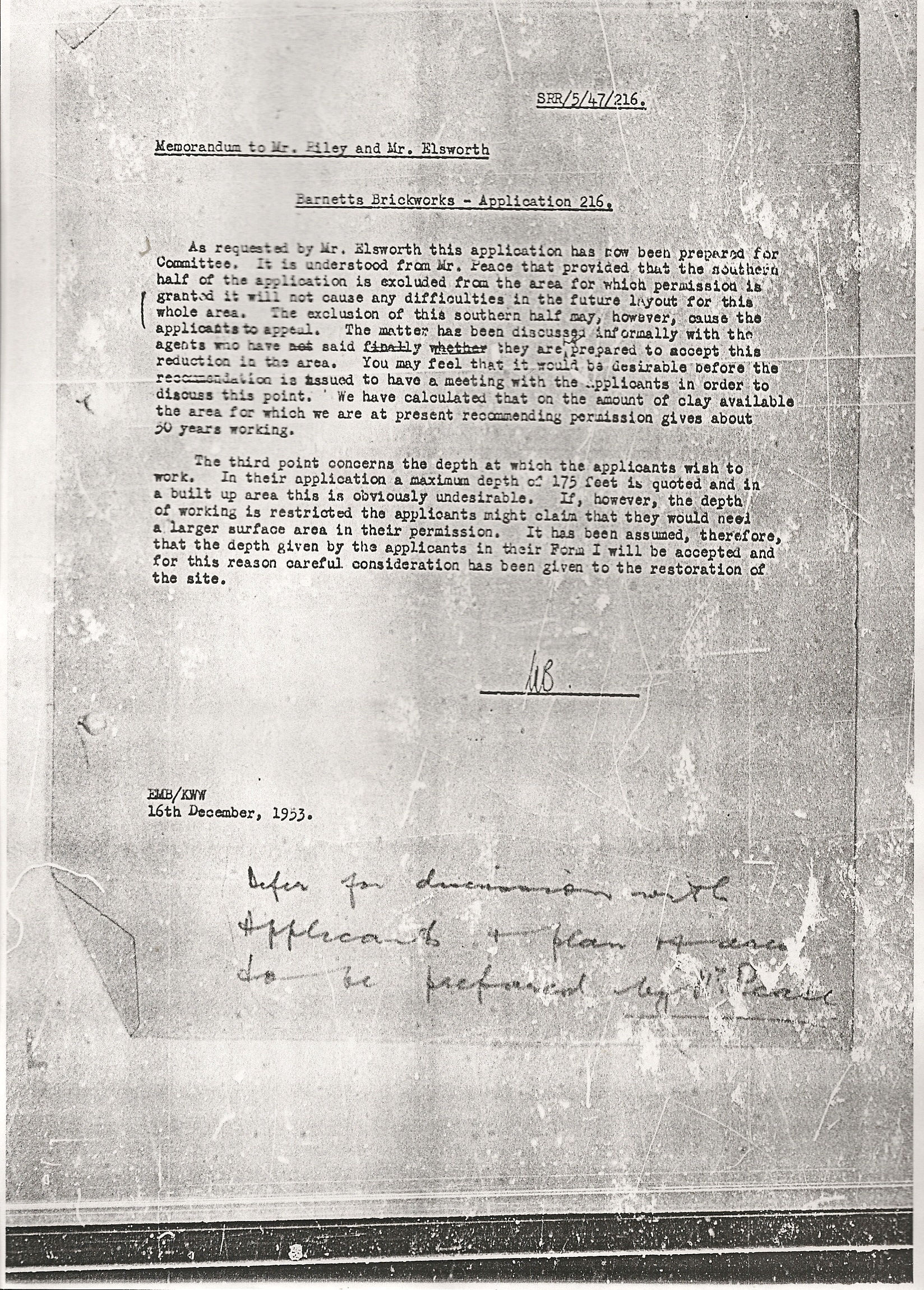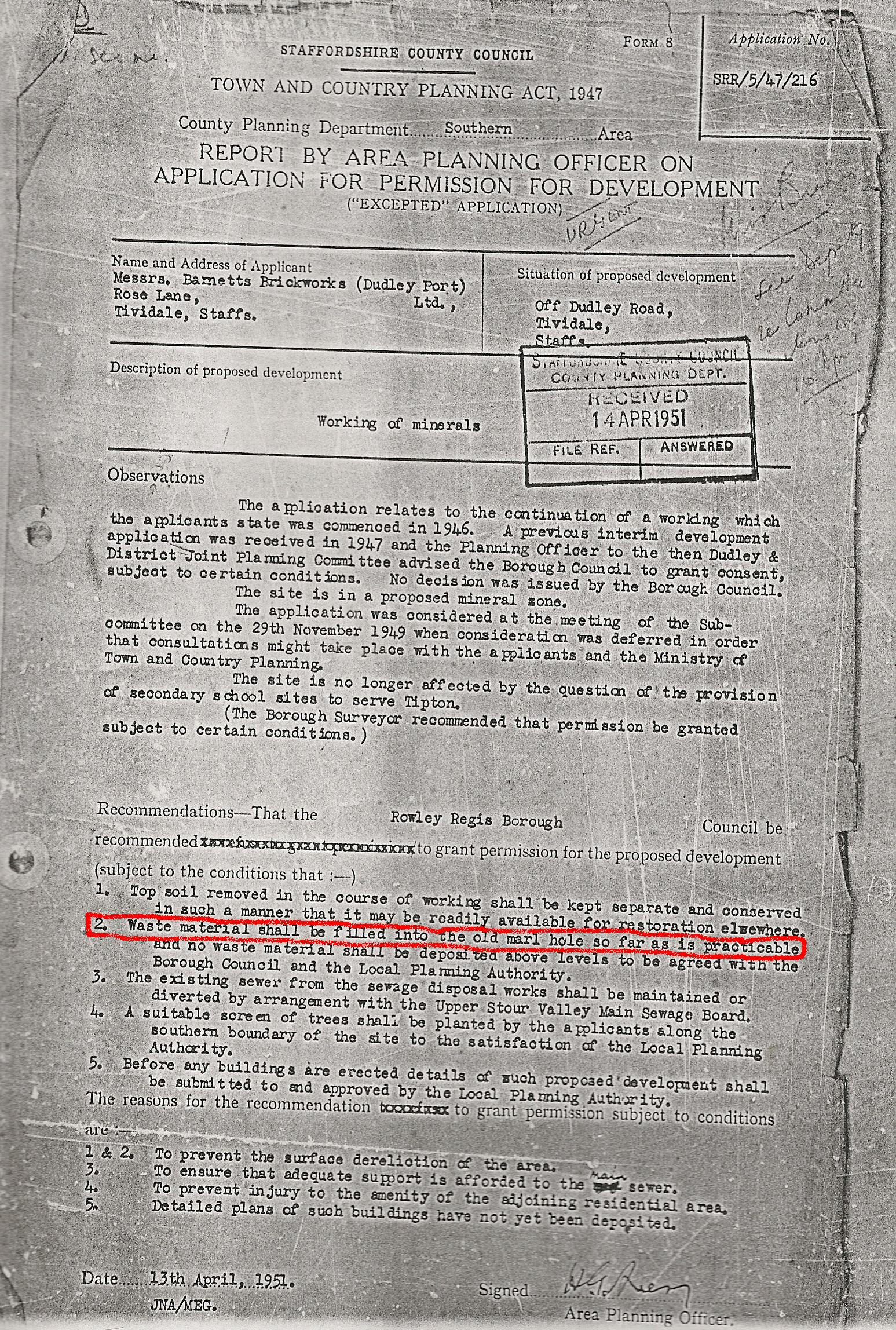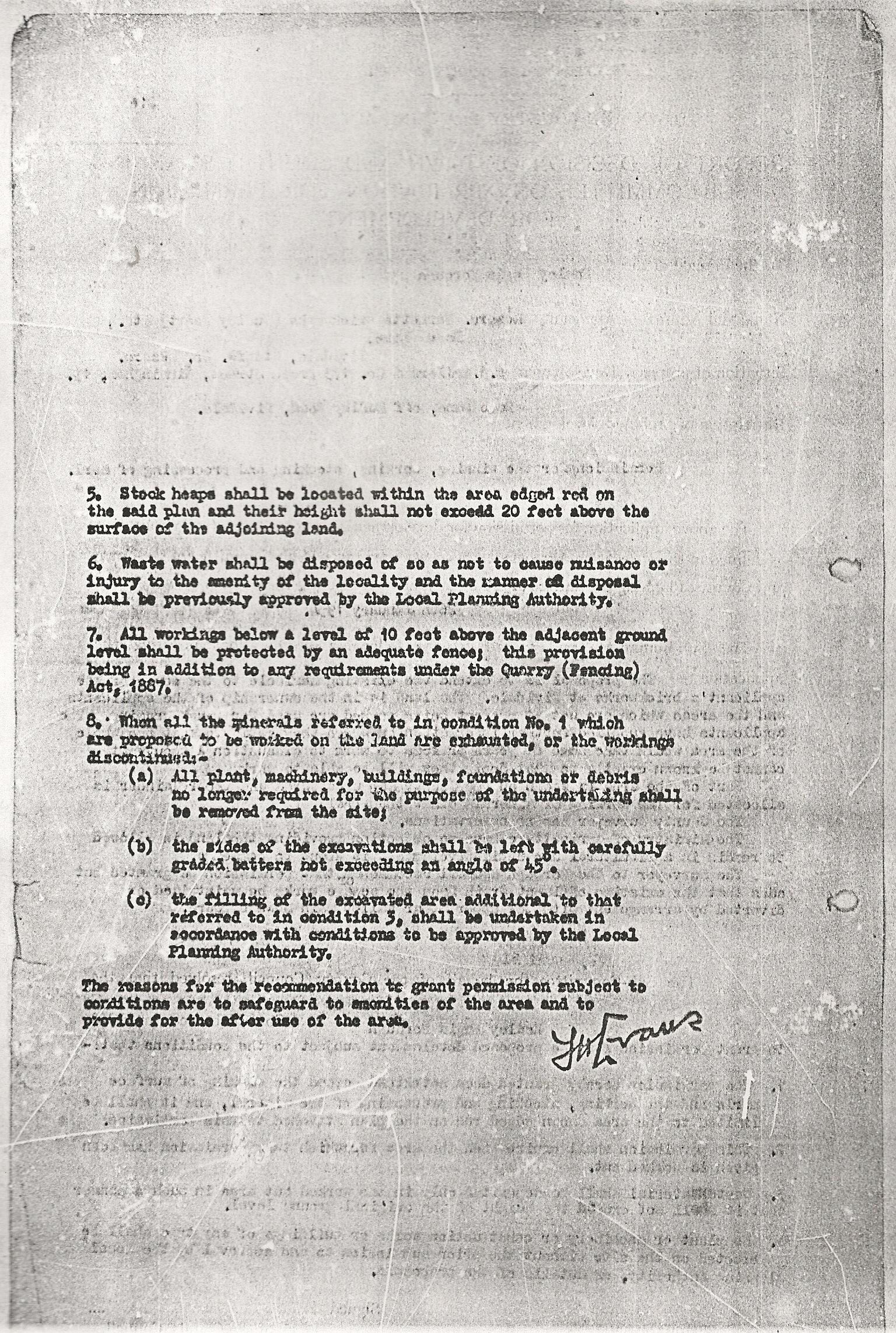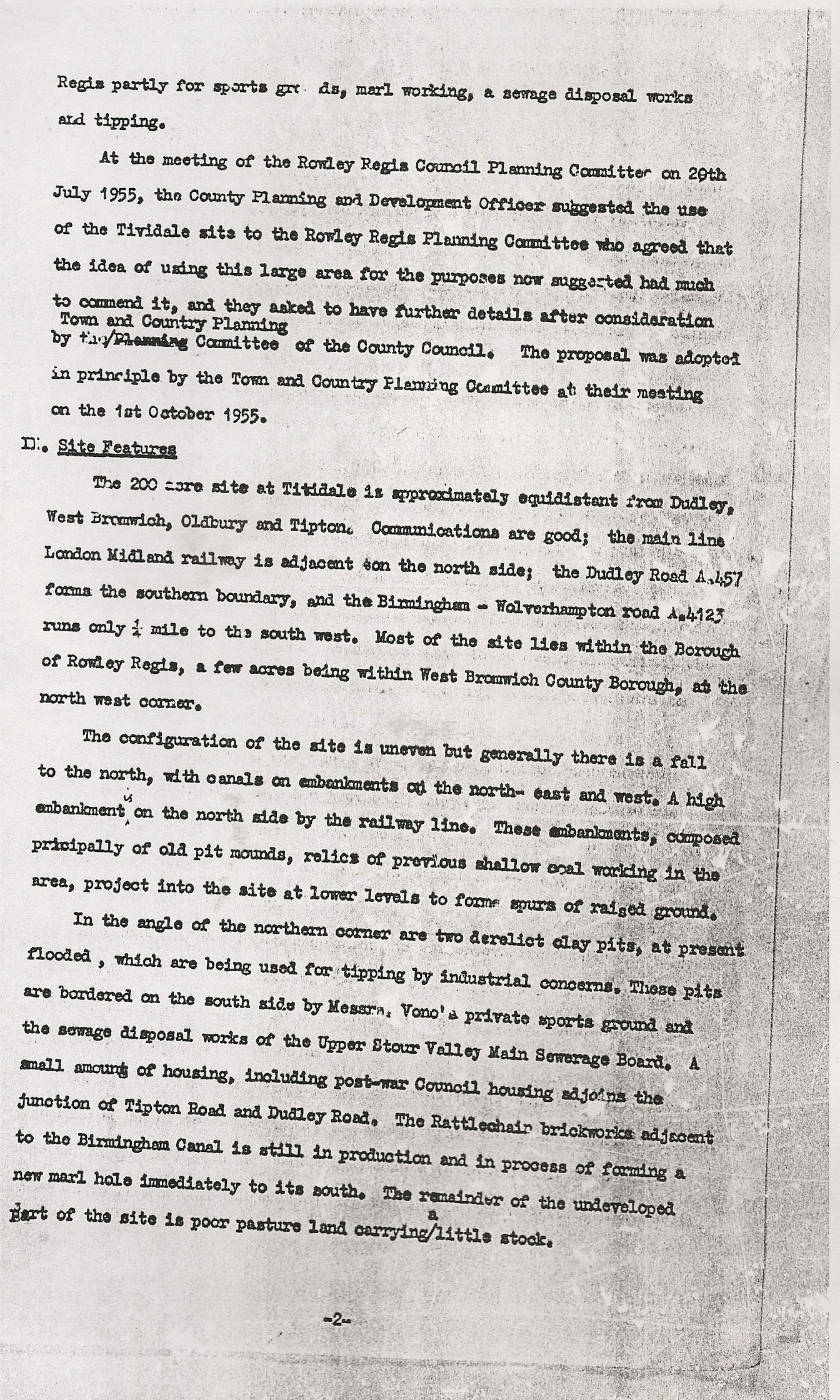LIST OF CHRONOLOGICAL PLANNING APPLICATIONS AND SUMMARY OF DEVELOPMENTS ON THE RATTLECHAIN BRICKWORKS SITE AND ITS ASSOCIATED CLAY PITS.
ID334/A34
This Interim Development order application has been microfilmed twice with these two numbers. There is little information recorded in the file which consists of just 3 pages.
“Barnett’s brickworks Ltd Dudley Port” are listed as applicant with what appears to be an “A Whitehouse” listed as “Managing Director Barnett’s Brickworks Ltd”. The application was for “Use of land for new clayhole, for prospective works expansion, and for tipping of waste.” No other details are given and there is no formal decision notice or letter filed,though the following plan is reproduced here. A letter from an unnamed planning officer in Rowley Regis council dated 6th June 1947 concerning “proposed excavations at Dudley Port for Barnett’s brickworks, Ltd” comments
“I suggest however that the council consider the imposition of conditions for the conservation and replacement of top soil, the ultimate level of the tipping and the protection of the council’s housing estate.”
It is later revealed in subsequent application 216, that no formal decision was ever made for this application, despite recommendation for approval.
The plan above shows the extent of area (around 62 acres) which appears to belong to the Barnetts brickworks area in dark hatching. This includes the entire ratlechain old pit area which became Rattlechain lagoon, and runs along the original John’s Lane to the west. The plan of the sewage works, now Callaghan Drive, is shown to the immediate south. The position of the former vono sports ground and pool lies south west of this. To the south east a substantial area of unmarked land bordering the mentioned “council housing estate” at Lower Chapel Street is marked. Rose Lane, a right of way, extends North from here, with the River Tame brook also clearly visible.
To the North the area runs parallel with The Birmingham Canal Mainline, including the basin which served the works.
Despite the lack of detail concerning the old pit, one should not draw conclusions from this limited map that the rattlechain lagoon site was not being used at this time as a waste tip. Even on later applications concerning the brickworks, there is no mention of this site being used by the Albright and Wilson company, and it seems to have been something that appears off the radar.
778 Use as a foundry Approved 02/02/51
Messrs Barnett’s Brickworks (Dudley Port) Ltd, Rose Lane, applied for part of the premises to be used as a foundry at the end of 1950 which was granted on 2nd February 1951. There is not much information given for what the foundry is for, but brickmaking and a blacksmith’s shop are mentioned, and the area given is 2500 sq ft.
On part 10 of the application form “If the building is to be used wholly or partly for industrial or commercial use state. (iv) if for industrial use, the means of disposing of any trade refuse or trade effluents.” the response
“own tip” is given. Given the date of the application, in 1950, this appears to suggest that the applicant was refering to the former clayhole pit (the rattlechain lagoon area). THIS CRUCIALLY APPEARS TO CONFIRM THAT ALBRIGHT AND WILSON DID NOT OWN THIS SITE! If they had, then a form b would presumably have had to have been submitted, given that it was in a different ownership.
This application is signed by an “S. Sheldon” listed as managing director of the company. Thus it can be revealed that at the turn of the decade it was Sydney Sheldon who still owned the rattlechain claypit that became rattlechain lagoon, and was obviously leasing the former pit out as a tip at this time. ie there was no “aquisition” by Albright and Wilson of this land at this time, as has been suggested on all of Rhodia’s claims about the site. They were just dumping their waste there on someone elses tip.
This plan is limited and shows the old marl hole (rattlechain lagoon area) above the brickworks building. The smaller “new marl area” is marked, which is later revealed in planning application 216 was commenced on September 6th 1946.
994 withdrawn 02/07/52
Proposed non ferrous metal merchanting and manufacturing.
We get the first incling here, that despite being a managing director of a brick making company that had been in existence at the site for some 100 years in one form or another, that Sydney Sheldon had his sights set upon other concerns for this land, despite the earlier applications.
H.B Barnard and Sons of Dudley Port are listed as applicants and prospective purchasers of the Barnett’s brickworks land. The application was approved for “Non ferrous metal merchanting and manufacturing”. The plans received in December 1951 confirm the “old marlhole” (which is Rattlechain lagoon), and the new marlhole to the East, but there is however still no mention of the land belonging to Albright and Wilson, which it has previously been universally agreed would have been in their ownership at this time.It was obviously not. See plan below.
The following letter from the Ministry of Agriculture appears to confirm that the land associated with the brickworks was poor grazing land, making it probably unsuitable for agricultural holdings. The problem of “fly grazing” of horses in the area continues to the present day, but obviously “gypsies” grazed it in the early 1950’s which possibly generated another source of income for Sheldon other than brickmaking.
A letter on this file to The area planning officer dated 2nd July 1952 also confirms that the applicants withdrew the application “in view of the fact that they have been unable to agree terms for the purchase of some of the land.”
It is obvious that they could not agree on some point with the owner of the brickworks. We wonder if it was related to the illicit tipping that appears to have been going on at the old claypit?
The plan above is limited, as it is not in colour as refered to. It is possible to note however the right of way of Rose Lane marked in dark (blue). NB There is no boundary between the former clay pit and the new brickworks pit, which again appears to suggest no site boundary and that Albright and Wilson do not own this site. There are no markings on the plan that it is even being used as a tip of any sort, although it obviously was being by now.
216 The winning, working, stocking and processing of marl Approved with conditions 3/2/54
A CRUCIAL PLANNING APPLICATION THAT HAS RAMIFICATIONS WHICH REMAIN TO THE CURRENT DAY.
It appears that this application had originally been submitted in 1948 under the title “working of minerals”, but deferred despite original recommendation for some considerable time because of discussions on future land use for the whole area. There are several letters on file relating to the lack of school provision in the area, and also the mentioning of a potential “black country cultural building”- Perhaps these were the potential origins of The Black Country Living Museum.
The Forms below helpfully confirm the status of the original A34/ID334 application, in that no decision was ever made.

The applicants, Barnetts Brickworks, Dudley Port Ltd, through their agents F.A Sellers of Oldbury, presented several pieces of information in the original application relating to the workings at the site. These can be read here and here. Quarrying operations on the “new” marlhole are listed as starting on September 6th 1946, whilst reference to the old marlhole (rattlechain lagoon claypit) is alleged to have started in 1846, as Rattlechain brickworks.
The most striking thing concerning this application, lies in the information supplied to the planning authority which gives conflicting information concerning the performance of Sydney Sheldon’s site in terms of brick manufacture. In the original application it was stated that the estimated output was about 7 million bricks or 28,000 cubic yards of clay per annum. This is also the figure given in 1939 with clay still being extracted from the older pit.
During the course of deferment of the application, the following file note is submitted to a Mr Hart dated 5th April 1951. “According to the valuation returns he produced 3.5 million bricks in 1948 and the average selling price was £8 per 1000 bricks.” This value therefore gives an estimated income of £28,000 per year- a hell of a lot of money in 1948.
“These brickworks are old and in very poor position. Before the war he had 40 to 50 people working for him, in 1949 he had only about 15, and his works were working at only about 25% capacity.”
After some protracted discussions however, just 2 years after this memo, we get a completely different picture presented by agents F.A Sellers and Co regarding the sites fortunes.
A letter dated 21st January 1954, acting for Barnett’s brickworks state
“At the time of the application was made in 1948, the estimated output was given as about 7 million bricks or 28,000 cubic yards per annum. Plant had been improved and modernised so that output now exceeds this amount.”
A figure of 10 million bricks per annum is mentioned.
Such a conflicting set of cirmcumstances appears to be rather difficult to believe, that in just 3 years, a tale of woe about manpower and output should turn to rapid expansion, in that the old buildings had suddenly been upgraded, (without any apparent planning permission!) It should be remembered however that Sheldon also had his fingers in the pie of allowing waste dumping into the old pit by a large chemical company (and who knows who else), which could have considerably swelled his financial fortunes.
A QUESTION OF DEPTH AND TIME
Along with the discrepancies concerning the site, the other reason for delay in considering the application appears to be estimates of how long the application should be allowed to run for and the amount of marl that could be extracted from the new pit. The two letters below show that the planning authority were confused as to how long it would take the new pit to be dug out, based on figures submitted by the brickworks and their agents.
It appears that the planning authority were mindful that the depths refered to on the original plan at 175ft were undesirable in a built up area. Considered here also should be the earlier letter from FA Sellers admitting that the area was prone to “slip”. This is equally confusing given that the abandoned pit opposite, as well as the foundations that their brickworks were built on had been in operation according to them on and off for around 100 years. Apart from the obvious collapse in 1899 and canal breach, the old pit had been worked deeply without any apparent problems to at least 1939, according to their submitted information.
A meeting with planning officers on 18th January 1954 involving Sheldon and his agents records more detail about the contentious delayed application.
So from initially claiming that the application would be for 100 years, we now have a much more limited timeframe of around 60. As will be evidenced however by subsequent change of use applications for the site, this figure cannot have ever been the true realistic intention of the site owner.
In terms of the old abandoned pit (rattlechain), there are a couple of interesting references in this application, which confirm that waste from the new marl pit would be allowed to be tipped into it- THIS REMEMBER AT A TIME WHEN ALBRIGHT AND WILSON ARE CLAIMED TO BE NOW DEPOSITING THEIR CHEMICAL WASTE.
Crucially a report in 1951 by the area planning officer states “Waste material shall be filled into the old marlhole so far as is practicable and no waste material shall be deposited above levels to be agreed with the Borough Council and Local Planning Authority.”
An estimated quantity of “about 200 tonnes per annum” is listed by the agents F.A Sellers and Co. THIS CONFIRMS THAT ANY WARTIME MATERIALS DEPOSITED INTO THE OLD MARLHOLE (RATTLECHAIN LAGOON) WOULD HAVE BEEN COVERED OVER WITH THE WASTE MATERIALS FROM THE NEW MARLHOLE DURING THIS PERIOD. WORSE THAN THIS, THIS PRINCIPLE OF “TIPPING” AT THE SITE, GIVEN THE PRECEDENT BY PLANNING PERMISSION 216 WAS TO INITIATE A DISASTROUS BACKFILLING OPERATION, WHEREBY THIS PLANNING CONDITION WAS MISUSED TO JUSTIFY WHOLESCALE INDUSTRIAL ILLICIT TIPPING OF HAZARDOUS WASTE.
A plan for the site also confirms that there was “a right to tip into the old marl hole for 2 years from April 1948.” Does this refer to the original Id334 application, which makes no reference to this at all, or another deal?
Given that Sheldon appears to have found a new found enthusiam for marl taking during this time, it is not so clear as to what he was doing with waste during the long deferred application becoming a reality. The planning officers do not appear to ask any questions about this, and it should be feared that this green light to dispose of waste into the old marl hole would have been misused during this period. By the time of the 1954 approval, this condition has been ambiguously reworded.
“Waste material shall only be deposited in the worked out area in such a manner that it will not exceed the height of the original ground level.”
But which “worked out area” are they talking about here, and why did they change the condition wording from “old marl hole”? There is no explanation on the file. A further important condition was that the permission would expire when the area to be worked out was completed. THIS DID NOT THEREFORE ALLOW SUBSEQUENT TIPPING OPERATIONS TO BE ALLOWED TO CONTINUE ON THIS SITE, AFTER THIS PIT HAD BEEN DUG OUT, AND NOR SHOULD IT EVER HAVE BEEN REGARDED AS SUCH.
Another plan on file of the wider area shows the different planning application areas. It is interesting to note that both the rattlechain lagoon claypit and also the vono claypit to the West are labelled as “tipping areas”. There is no mention here of Albright and Wilson, and no form b completed by Sheldon or his agents concerning the land. It begs the question as to whether both of these two flooded areas were one big chemical dump at this time, and even if Albright and Wilson were also using the Vono pit in addition.
2583 Use of the existing brickworks for metal washing plant and storage, and the tipping of foundry waste on the land shown hatched red at Rose Lane, Tividale. Approved with conditions 3/9/58
This is another indication that brick making was not starting to figure in the long term plans for the site owner. The applicants were ironically The phosphor bronze company Ltd of Bradford Street Birmingham. Perhaps the last thing the area needed was more white phosphorus contaminated material! This application was for the entire brickworks site, that remember had been applied for by Sheldon to last for 60 years in the previous application 216. What a difference 4 years made. The phosphor bronze company required the brickwork buildings for their metal extractions plant, the new marlhole, that Sheldon had purposefully dug quickly and shallower than first anticipated and land to the west for “tipping of waste”- unspecified as to what type- though p4 is likely to have been present given the nature of phosphor bronze manufacture. They also wished to use the rest of the site for “industrial purposes”.
It was granted approval to allow permission till the end of 1963, though it is clear that the phosphor bronze company wanted a far longer extension. The agreement for industrial purposes was refused based on the pre allocation of the land for recreational purposes. The note also confirms the right of Way status of Rose Lane.
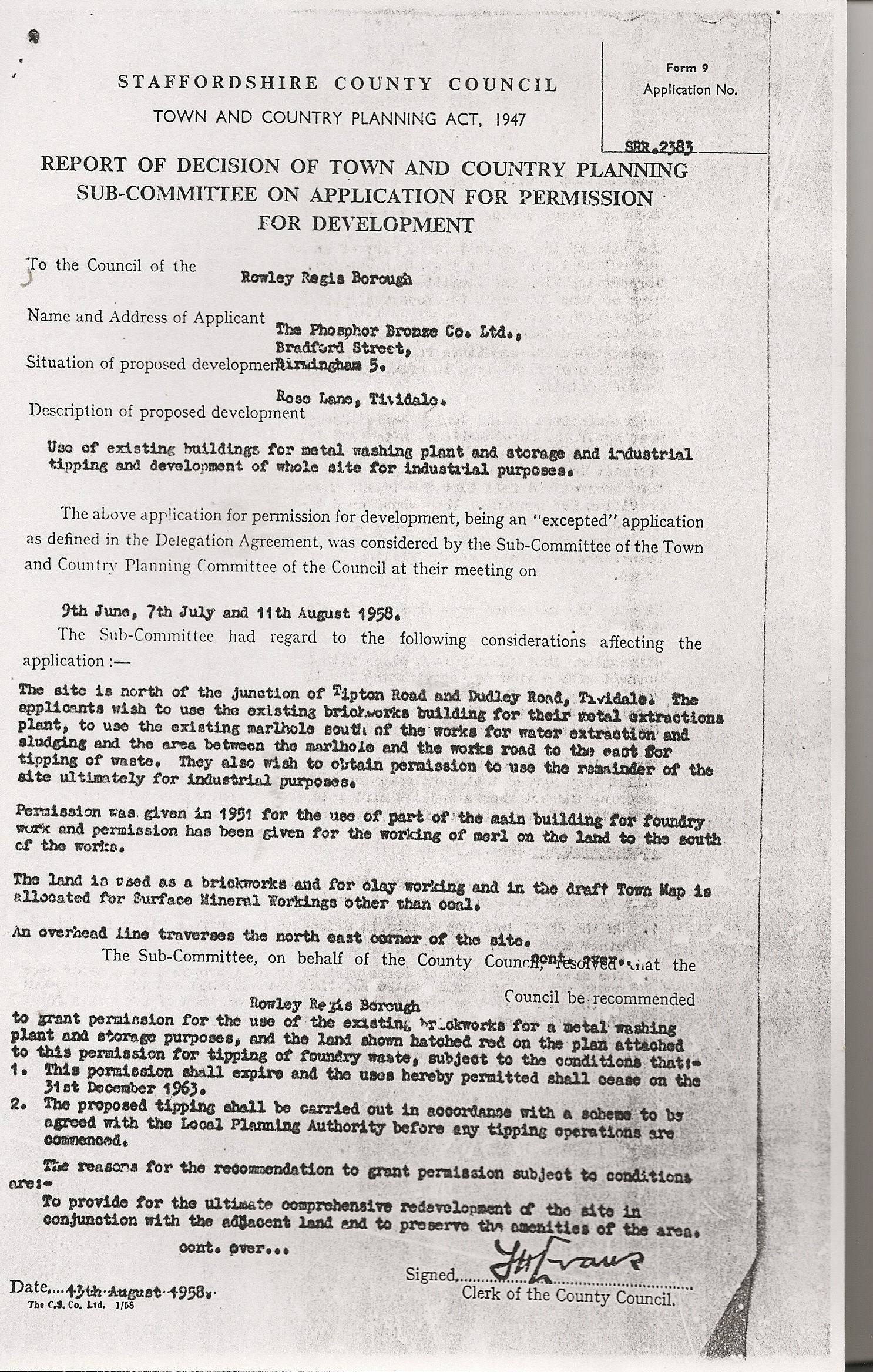

A report on the proposed Recreational and cultural centre referred to previously from 9th June 1958, gives some fascinating insight into the wider planning area at this time.
We also have here a detailed site footprint left behind in the sand. “This site extends to some 200 acres and is allocated on the draft Town map for Rowley Regis partly for sports grounds, marl working, a sewage disposal works and tipping.”
It continues
“In the angle of the northern corner are two derelict clay pits, at present flooded, which are being used for tipping by industrial concerns. These pits are bordered on the south side by essrs Vono’s private sports ground and the sewage disposal works of The Upper Stour Valley Main Sewerage Board. A small amount of housing, including post-war Council housing adjoins the junction of Tipton Road and Dudley Road. The Rattlechain brickworks adjacent to The Birmingham Canal is still in production and in process of forming a new marl hole immediately to its south. The remainder of the undeveloped part of the site is poor pasture land carrying a little stock.”
It is perhaps ironic that the activities being carried out at this proposed “black country cultural site” during this time were Black Country “cultural activities” such as brickmaking, marl extraction and land being “grazed by gypsies”- though perhaps these plebian activities were not the desirable ones wanted by the planning authorities.

Prior to approval being granted, a meeting took place between Rowley Regis council and the Phosphor bronze company and their agents, which included Sydney Sheldon in capacity as land owner. It is quite clear from this meeting as to what Sheldon’s true ambitions were and had been all along.
HE WANTED SHOT OF THESE WORKS AND BRICKMAKING, APPLICATION 216 WAS A RUSE TO DIG A LARGE HOLE AND MAKE AS MUCH AS HE COULD IN AS LITTLE TIME AS POSSIBLE, AND THEN TO FLOG OFF THE LAND FOR TIPPING PURPOSES TO SOMEONE ELSE. THIS IS THE CLEAR PATTERN THAT ANYONE WITH ANY INTELLIGENCE COULD SEE TRANSPIRING. HIS ONLY CONCERN WAS MAKING MONEY OUT OF THE LAND AND NOTHING ELSE.
And so the limited time application was granted. It was however a false start, and probably a major blow to Sheldon’s scheming plan. It is later revealed in a subsequent application from 1963 that The phosphor Bronze Company mercifully never in fact took up residence at the site. It folded in 1959 – perhaps partly as a result of not getting permission for the time period that they wanted? It should be noted however that they had only moved from London to Birmingham just before the Second world war.
This left Sheldon with other avenues to explore- none of them it seems to do with brick manufacture that had supossedly been the long term aim for 60 years as granted by planning application 216 which earlier was forecast for 100. The application for the phophor bronze company is important given that it allowed them an outlet for tipping as this scheme gave them proviso to do but did perhaps Sheldon, as he retained the land believe that he had proviso to do so?
We believe that if Sheldon’s intention was to carry on with brickmaking at the site then he quickly changed his mind, realising that he could make far more money out of the site by leasing it out to other activities that had absolutely nothing to do with making bricks or extracting marl.







